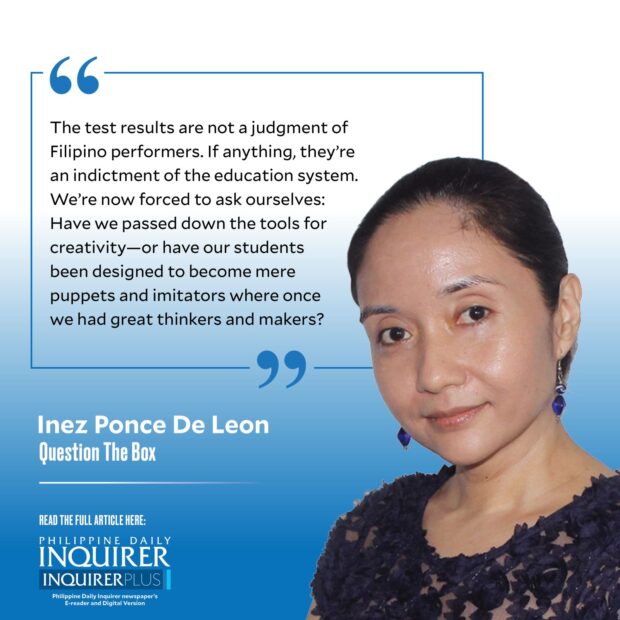
We teach a required undergraduate course in creativity at our department. When people hear about this class, they often ask why creativity has to be taught. The course’s full title tells the story: “Creativity and Problem Awareness.” It’s a systematic approach to unearthing problems, understanding the problem, and even imagining solutions.
It’s not just about performance, and it doesn’t even have to involve talent in the performing arts.
This misunderstanding of creativity came to the fore when the 2022 Programme for International Student Assessment (Pisa) test results revealed that our high schoolers rank well below the global average in creative thinking. This prompted outrage amongst internet users, who questioned the validity of a test written in English, which our students might not understand; and who contended that Filipino artists are known the world over, and Filipinos are therefore creative.
I will focus on this latter idea, and leave the pedagogy and linguistics to the experts.
There is a misunderstanding, I believe, of how creative thinking is defined. To examine this misunderstanding, we need to look at the Pisa test, which is available online.
The test comprises questions that can be answered in phrases or sentences. It begins with simple questions (give this photo a title, create a movie plot around this situation) and graduates to more complex ones (propose solutions to this environmental problem).
In nearly all the questions, there is a phrase that is repeated: write an original answer that not many people might think of.
While armchair philosophers might argue that nothing is original anymore, there is, nevertheless, a spirit to the question that students and critics might miss if they focus too hard on “write” rather than “think.”
The test measures whether a student can integrate context, prior knowledge, and details to articulate a novel answer. For example, most people might look at a photo and give it any title that comes to mind. A creative thinker will look at the individual parts of the photo, speculate on possible context and history, and weave all these together into a title.
Another example: Some people might look at a situation and make up a story, like an isolated episode with neither preface nor epilogue. A creative thinker will see the situation as driven by characters with their own motivations and goals, which then push characters to act in specific ways, which then lead to logical plot trajectories that propel the story forward.
A last example: When confronted with a complex problem (low vaccination rates, traffic, low popularity of public libraries), a pedestrian thinker will propose solutions that have already been tried (More information drives! More roads! More promotion!). A creative thinker might first determine the root of the problem and the group most affected by it, and then propose a solution that incorporates any previous information given, addresses the problem, and fits the context and characteristics of the target public.
This is only one kind of creative thinking, and it has been criticized for being top-down and messianic. There are other creative solutions, such as engaging communities so that they unearth and solve their own problems, or gathering experts so that they can all come to a common understanding of and solution to a problem.
Students who can exercise creative thinking, therefore, should show that they can critically appraise information, imagine or speculate, and articulate their insights.
Creative thinking, therefore, is not about intuition, feverish performance, or churning out things. Creative thinking involves a rigorous examination of what one is responding to, rather than making something simply because one wants to.
It’s also a process that all fields need and practice: businesspeople identify consumer needs; bench and social scientists carry out research responding to a need for more knowledge; those in the humanities create art to answer pressing questions on the human experience; those in education, medicine, and many other fields diagnose problems and propose solutions only after a thorough examination.
The protest online, therefore, confuses creative thinking, the process, with the products of creation.
Instead of proclaiming that we have a lot of artists and performers, let’s first think of how we define creativity. If we think that creativity is about performance, then we’re jeopardizing the next generation’s education by depriving students of the tools to help them think in disciplined, thorough ways.
But if we see creativity as a process, then we might come to the more liberating conclusion: that we can all be creative, and we all benefit from thorough, holistic thinking processes.
The test results are not a judgment of Filipino performers. If anything, they’re an indictment of the education system. We’re now forced to ask ourselves: Have we passed down the tools for creativity—or have our students been designed to become mere puppets and imitators where once we had great thinkers and makers?
—————-
iponcedeleon@ateneo.edu